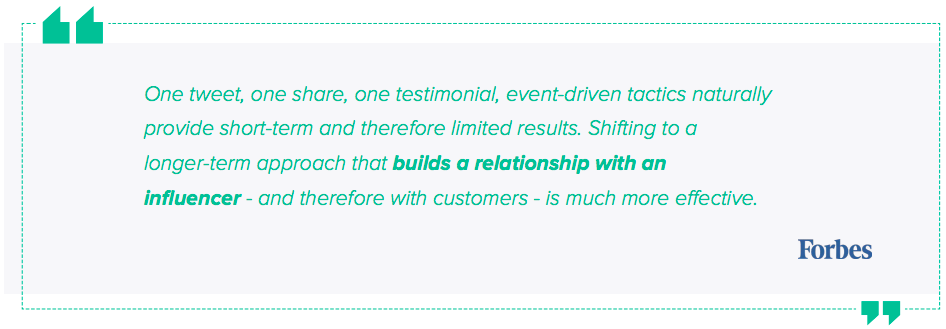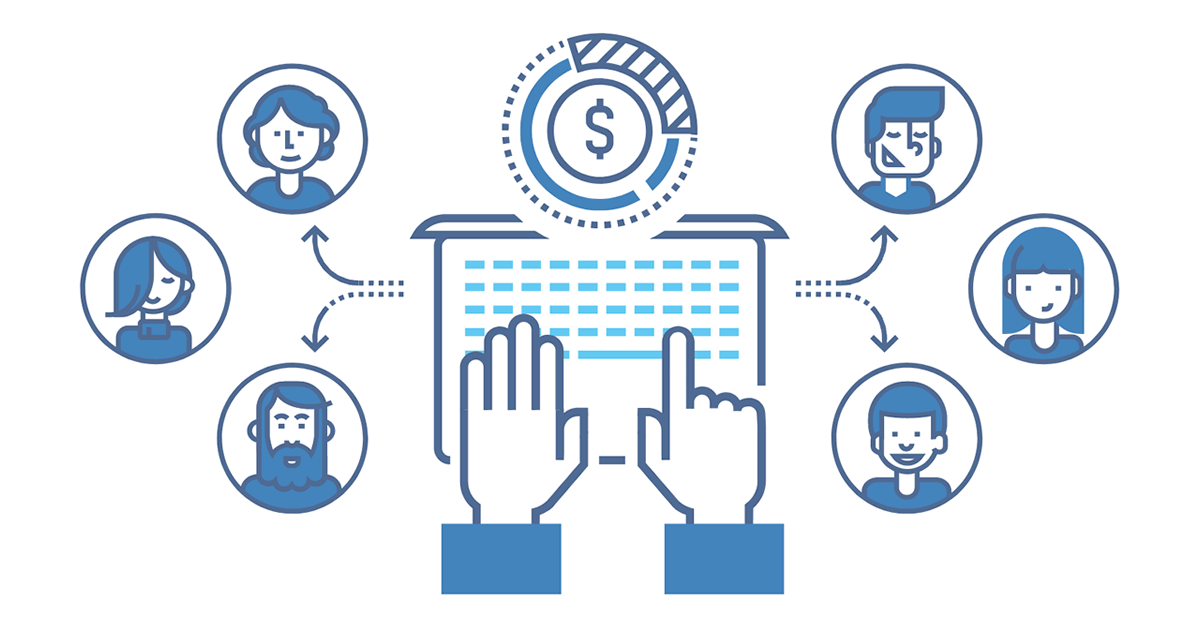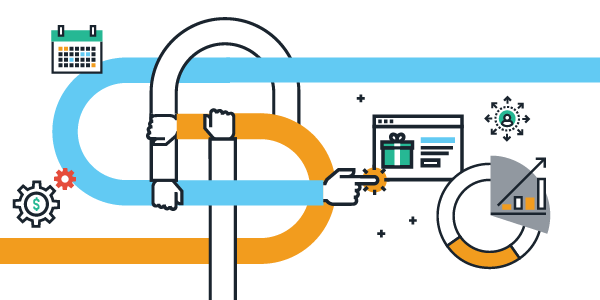Before you dive into this guide, let’s make a couple assumptions: First, your brand is already using influencer marketing. Second, you’re happy with where it’s headed and are looking to scale this acquisition channel. That’s where an influencer marketing platform enters the picture.
…a what?
An influencer marketing platform is a software solution that helps marketers be more successful in driving brand awareness, leads, and revenue from their influencers. You’re already leveraging subject matter experts, social-media influencers, and bloggers who want to encourage their followers to use your products and services, now it’s time to take it to the next level.
Brands that use leading-edge influencer marketing technology to automate the enrollment, communication, and reporting of – and for – their influencers, can easily scale and optimize this channel.
So, why are marketing teams still using spreadsheets and emails to track who received their latest product and what time it will post to Instagram?
Well, here’s the truth about influencer marketing: Coordinating influencer programs can be time-consuming, and the campaigns themselves can be costly, depending on the fees you pay to partners. So investing in technology on top of what you’re already spending can seem pretty overwhelming.
![]() But if you’re looking to impact the bottom line by bringing in more revenue via influencer marketing, partnering with a data-driven influencer management platform is crucial to your brand’s success.
But if you’re looking to impact the bottom line by bringing in more revenue via influencer marketing, partnering with a data-driven influencer management platform is crucial to your brand’s success.
Especially now as influencer marketing is gaining traction and understanding in the C-suite, engagement metrics just won’t cut it. Just like any other marketing initiative, reporting and optimizing is key in understanding the success of your influencer program.
Brands that leverage technology can provide influencers with the tools they need, track activity and conversions, manage payouts, as well as analyze trends and measure ROI. The ones that are able to automate emails, customize share links, and white-label their influencer marketing programs are the brands that will see the most success.
 Finding the Perfect Influencer Marketing Platform
Finding the Perfect Influencer Marketing Platform
In most cases, marketers manage influencer marketing manually — handpicking target influencers, reaching out to them individually, and tracking the program through spreadsheets and email.
There are some influencer marketing software programs designed to manage the procurement of the influencers themselves, which is usually via an agency with a matching algorithm. But these software programs do little to help with the process of managing influencers, attribution, payouts, reporting, and further empowering influencers to perform better. This is where marketing automation can step in to save the day.
But we know feature-rich technology can get confusing. So, let’s breakdown the “must-haves” when looking for a social media influencer platform:
1. Own the Registration Process
 Influencers understand their audience better than anyone and they are actively seeking meaningful relationships with brands they already know and love. Make sure your program is accessible on your website, because that’s where most influencers go first to engage with brands they WANT to work with.
Influencers understand their audience better than anyone and they are actively seeking meaningful relationships with brands they already know and love. Make sure your program is accessible on your website, because that’s where most influencers go first to engage with brands they WANT to work with.
One of the best ways to do this is to provide a simple one-page registration that allows influencers to apply or register for your program and triggers an automated email sequence with next steps to both the influencer and your marketing team. Also, be sure to require the proper legal terms and conditions acceptance as a part of on-boarding.
2. Customizable Influencer Portal
![]() Often times brands assume influencers are amazing content creators, this is often not the case. Proactively provide your influencers with quality, brand-approved assets, customizable share links, and codes to make promoting the brand or specific products easy.
Often times brands assume influencers are amazing content creators, this is often not the case. Proactively provide your influencers with quality, brand-approved assets, customizable share links, and codes to make promoting the brand or specific products easy.
The portal should also allow influencers to upload images or content for your approval prior to posting. Lastly, deliver reporting back to your influencers on their performance, with their own personal analytics dashboard.
3. Security & Control
 Beyond controlling individual influencers, the right platform should enable you to make changes to the program (based on terms and conditions, influencer groups or segments, and commissions, etc.) that affect all influencers, in real-time. Ensure complete control while automatically flagging any suspicious activity, and even ban influencers.
Beyond controlling individual influencers, the right platform should enable you to make changes to the program (based on terms and conditions, influencer groups or segments, and commissions, etc.) that affect all influencers, in real-time. Ensure complete control while automatically flagging any suspicious activity, and even ban influencers.
4. Automated Cash Payouts
![]() Deliver real-time or scheduled automated cash payouts to your influencers, all within one platform. You don’t want to waste time with manual checks or logging into multiple accounts or systems. And, your influencers don’t want to have to follow up asking when, and how much they will earn, that’s another aspect to the portal. Beyond automated payouts, and email notifications, the portal should be able to show each influencer how much they’ve earned, when, and for what.
Deliver real-time or scheduled automated cash payouts to your influencers, all within one platform. You don’t want to waste time with manual checks or logging into multiple accounts or systems. And, your influencers don’t want to have to follow up asking when, and how much they will earn, that’s another aspect to the portal. Beyond automated payouts, and email notifications, the portal should be able to show each influencer how much they’ve earned, when, and for what.
5. Advanced Program Analytics
 See which influencers are generating the most clicks, leads, customers, and revenue and by which channels (FB, Twitter, blogs, etc.). You want to be able to run cohort analysis and optimize your program in real-time.
See which influencers are generating the most clicks, leads, customers, and revenue and by which channels (FB, Twitter, blogs, etc.). You want to be able to run cohort analysis and optimize your program in real-time.
Now that you know what to look for as you vet brand influencer marketing platforms, the real work begins.
 Influencer Marketing Strategy: The Road to Success
Influencer Marketing Strategy: The Road to Success
As influencer marketing becomes ubiquitous, however, another realization has crystallized: it’s not enough to track down an influencer’s address and ship them product with a personalized coupon code to share with their followers. Not all influencers are created equal, and the best way to ensure successful campaigns is to develop relationships with both paid and organic partners who can employ a multi-touchpoint approach.
You could say, there’s an art to influencer marketing.

In order to ensure success (and ROI on technology), let’s dive into how to make your influencer marketing strategies pay off.
1. Identify influencers who connect with your brand’s core values
![]() Sure, you can look at a potential influencer’s number of followers to get an idea of their social media presence and clout, but your analysis should go beyond that. Do they currently or have they in the past used your product? Is their audience your ideal customer profile? Influencers who have a natural affinity with your brand and its core values can generate more compelling – and higher converting – promotions than someone with a million or more followers but less personal interest in the product. Quality over quantity always wins.
Sure, you can look at a potential influencer’s number of followers to get an idea of their social media presence and clout, but your analysis should go beyond that. Do they currently or have they in the past used your product? Is their audience your ideal customer profile? Influencers who have a natural affinity with your brand and its core values can generate more compelling – and higher converting – promotions than someone with a million or more followers but less personal interest in the product. Quality over quantity always wins.
Similarly, as studies have shown that potential consumers often only convert to traffic or customers after seeing a product multiple times, you want to identify whether influencers are meaningfully engaged with followers on multiple platforms. Can they deliver content that’s authentic and more than just a one-off? Before you sign paid contracts for influencers, make sure they are skillfully creating content on multiple channels, and that your brand’s values sync with theirs.

2. Use influencer campaigns to bolster traditional multi-channel marketing
 Savvy marketers today are taking spend allocated to paid advertising and applying it toward influencer marketing knowing that this strategy will generate truer organic impressions, more quality click-throughs, and higher conversion rates. While influencer marketing has eclipsed its trendy beginnings, it’s still no replacement for integrated campaigns that drive brand awareness, website traffic, and product sales.
Savvy marketers today are taking spend allocated to paid advertising and applying it toward influencer marketing knowing that this strategy will generate truer organic impressions, more quality click-throughs, and higher conversion rates. While influencer marketing has eclipsed its trendy beginnings, it’s still no replacement for integrated campaigns that drive brand awareness, website traffic, and product sales.
Users are smarter than you think and they’re becoming more and more sophisticated. Especially if you’re a consumer savvy fitness or fashion brand, influencer marketing runs the risk of not even reaching your audience. Users are familiar with sponsored posts and are prone to tune them out.
But taking all this into consideration, internal marketing campaigns are easier to measure and analyze, and consumers expect reputable brands to have a considerable online presence of their own.
Influencers can enhance marketing and diversify a brand’s target audience, but companies should use influencer marketing campaigns to elevate their existing marketing, not rely on influencers exclusively.

3. Utilize brand ambassadors in addition to paid influencers
![]() Your brand might get the most exposure, numerically speaking, from a niche-celebrity that has a large social following, but partnering with a brand ambassador can be even more beneficial for your brand and a lot friendlier to your budget.
Your brand might get the most exposure, numerically speaking, from a niche-celebrity that has a large social following, but partnering with a brand ambassador can be even more beneficial for your brand and a lot friendlier to your budget.
Ambassadors – customers, fans, followers – are in it for the perks and their love of the brand, not the pay, which means that their word-of-mouth can really capture the heart and soul of your product and company. Additionally, an influencer program that relies on ambassadors is a great way to integrate a specialized referral program. The most effective way to get your customers to invest in your brand is to invest in them. Entice participation in a referral program with a purposeful reward structure; generate more revenue by running segmented campaigns to your most loyal customers; increase brand awareness by encouraging sharing through refer-a-friend programs.
By providing an avenue for promotion by your brand’s biggest fans, you build a well-oiled marketing machine that runs on dedication and doesn’t require the same level of vetting as other types of influencer marketing.


The Rise of Influencer Marketing
Over the past several years, influencer marketing has expanded exponentially. And as we mentioned, the premise of it is quite simple: Incentivize people with (typically) large, captive followings to talk about a company’s products or services. This approach provides social proof by linking a sought-after persona to your brand.
The thing is, influencer marketing is not new.
It’s actually rooted in affiliate marketing and if we take a look at this tactic, we can learn a thing or two about the best way to approach influencer marketing.
Historically, affiliate marketing has been very transactional. Its success (and cost) has depended on how much a brand is willing to pay a publisher to display their ads. Affiliate marketers tend to use more antiquated forms of media like email and PPC ads. They’re not contacting close friends, but rather looking for maximum exposure.
This is why brands leverage affiliate networks saturated with affiliates that are hungry to post their content and rake in their commission. The traffic generated are visitors searching for products online, and has very little to do with a prior relationship with the affiliate. While your brand may be getting more traffic, the likelihood of conversion is lower due to the lack of an authentic relationship.
Enter, the new generation of affiliate marketers: Influencers.

Influencers work mainly via social media platforms, text, and email, which makes sense, given the trust-based focus on peer-to-peer referrals these days. Brands leverage the existing relationships that influencers have with their large, captive, and engaged followings in exchange for a fee for their endorsement.
And just like affiliate networks, there are influencer networks popping up every day. Many of these influencer networks are primarily matching algorithms (see “agencies”) that match brands with trusted people (subject matter experts or niche-celebrities) or smaller publishers (bloggers) whose audience is one the brand seeks exposure to and are their most ideal customers.
That sounds…well, great, right?
It’s fast, easy, and predictable. The network agency already has access to hundreds, or thousands, of influencers the brand may not even know exist. And, you’ll know how many impressions your ad – or promoted material – will receive. All you have to do is supply content, and sit back and watch the marginal lift in traffic and conversions that quarter.
There aren’t many brands – consumer or commercial – that should shy away from this strategy. As long as your SEO and traditional paid campaigns are humming, this is a great next step in relationship marketing. If the impact isn’t as substantial as you like, your network will match you up with a different influencer, and you can try again. It’s much easier to manage one vendor who then manages multiple influencers and payments, etc.
Okay, so what’s the catch?
The downside is you’re renting. Your brand, and those influencers, are contractually bound to work through a network that acts as a perpetual middle-man. Maybe you find a great match with a few influencers, but the network has to service the influencer’s best interest equally. So when competitor X shows up offering 20% higher rates to promote their content, you can either pay higher rent or find a new apartment. Your brand doesn’t own that relationship and that influencer’s loyalty lies with the network who’s paying them.
Furthermore, you’re paying for impressions. The influencer generally has no incentive to help drive a prospect to purchase. This is not exclusively the case. The premium solutions will show you how they attribute conversions and revenue, but remember, you’re still paying to post.
 Influencer Marketing is the New Native Advertising
Influencer Marketing is the New Native Advertising
Now, let’s contrast that against how forward-thinking brands are approaching influencer marketing today.
Instead of outsourcing their relationship with influencers, brands are spending time identifying and screening potential ambassadors of their brand. They then leverage a platform that ensures complete transparency – for both parties – throughout the lifetime of their partnership. No middlemen means no percentage to middlemen.
And beyond that, successful marketers are running influencer programs where the promotional material is trackable through the point of purchase, so these brands are rewarding influencers for driving conversions and revenue, not just impressions. This type of marketing channel creates a mutually beneficial relationship for brands and influencers.
Who is this great for?
Brands that sell direct. If you’re an OEM only and you don’t own the point of sale, then achieving this type of organic, vertical integration can be challenging. However, whether you’re big or small, this type of relationship marketing via influencers all but guarantees a direct path to your most valuable customers and ensures you are rewarding for revenue, not posts.
When you target these types of influencers, it’s also more likely that you’ll be able to build more personal, connected relationships with the individuals — bloggers, experts, etc. — who are behind them, and therefore more loyalty. This turns influencer marketing into a channel that’s owned, which gives you more flexibility and control if market conditions change.
We know that people trust recommendations from other people they know—and that includes people they know via their online presence. In fact, 92% of 18-to-34 year-olds say they seek recommendations from friends and family when considering a product purchase—which makes word-of-mouth the highest ranked source for trustworthiness. This trust is leveraged in influencer marketing.
And as long as your company has a quality product or service that customers love, a captive and engaged audience, as well as, a process to track, manage, and pay influencers, this marketing strategy will work for you.
